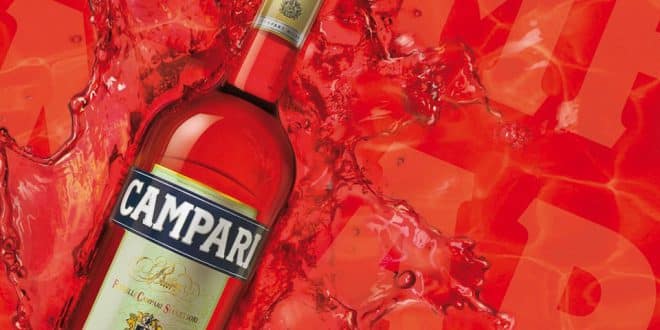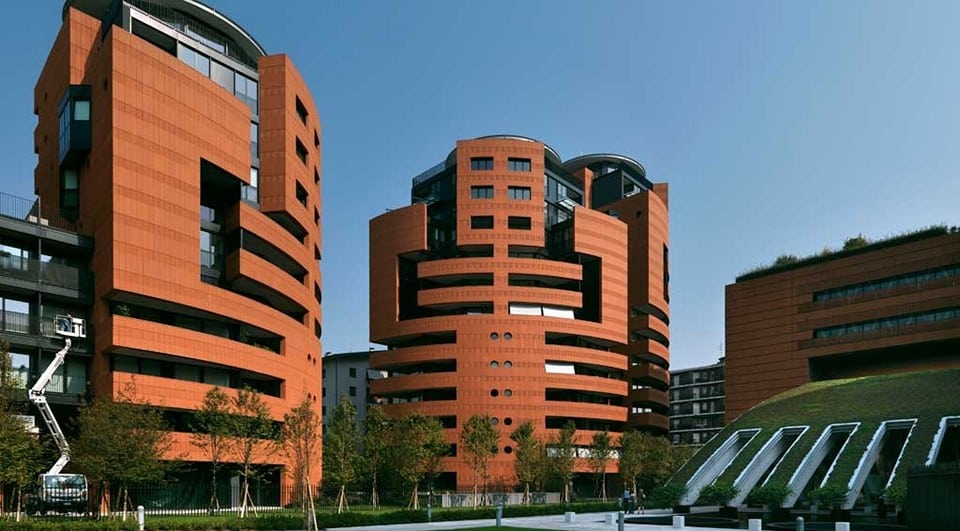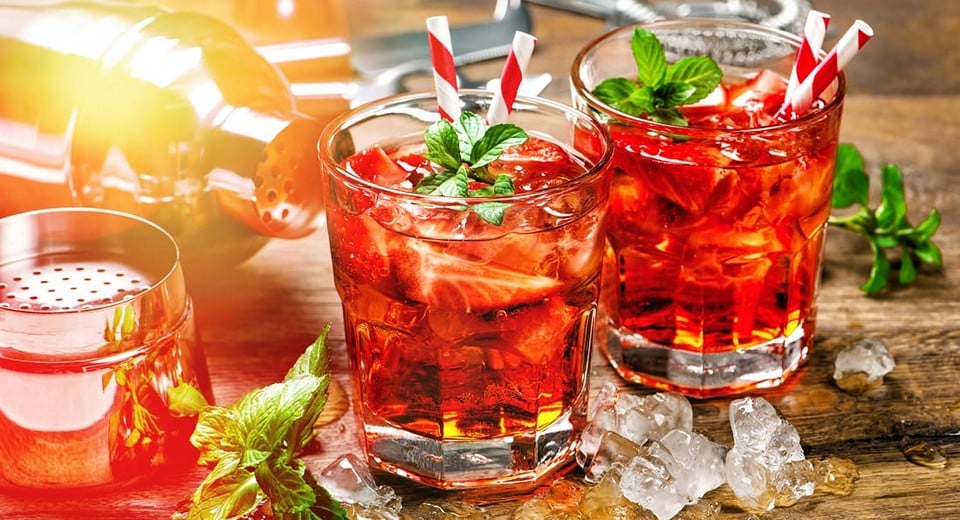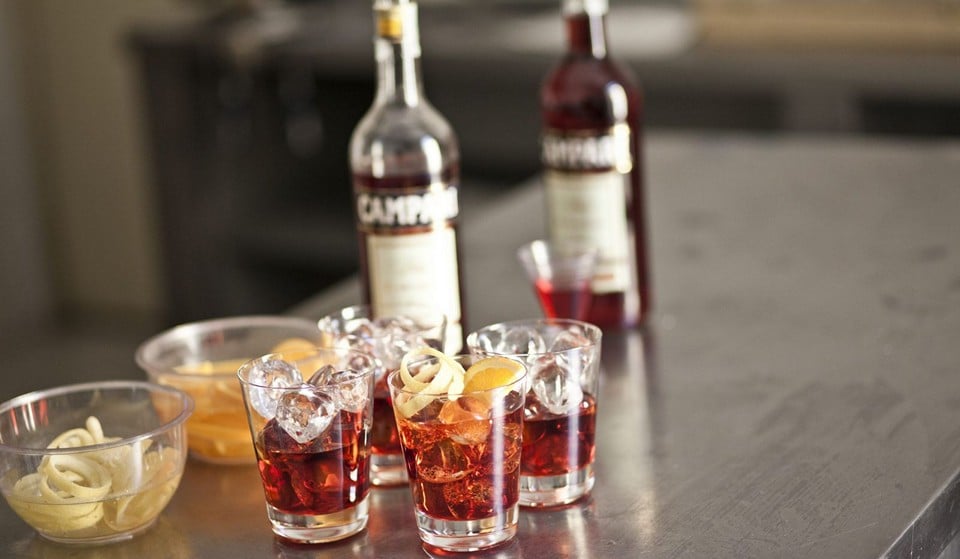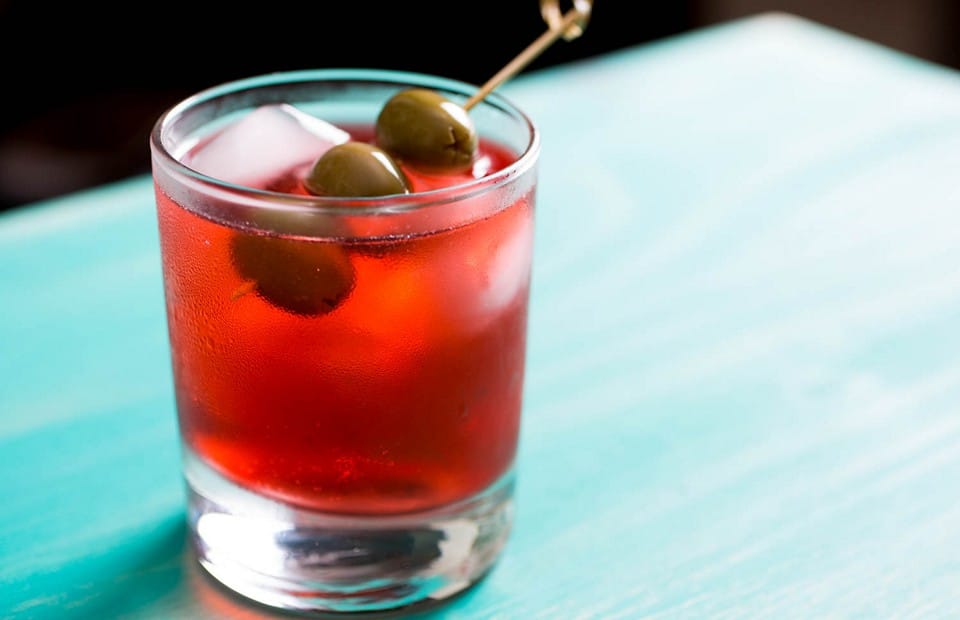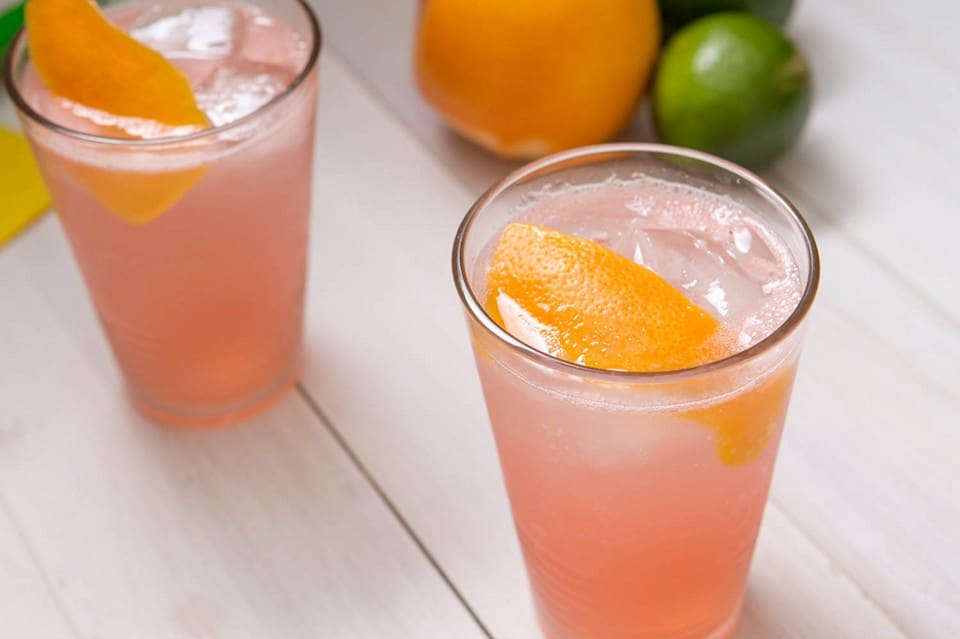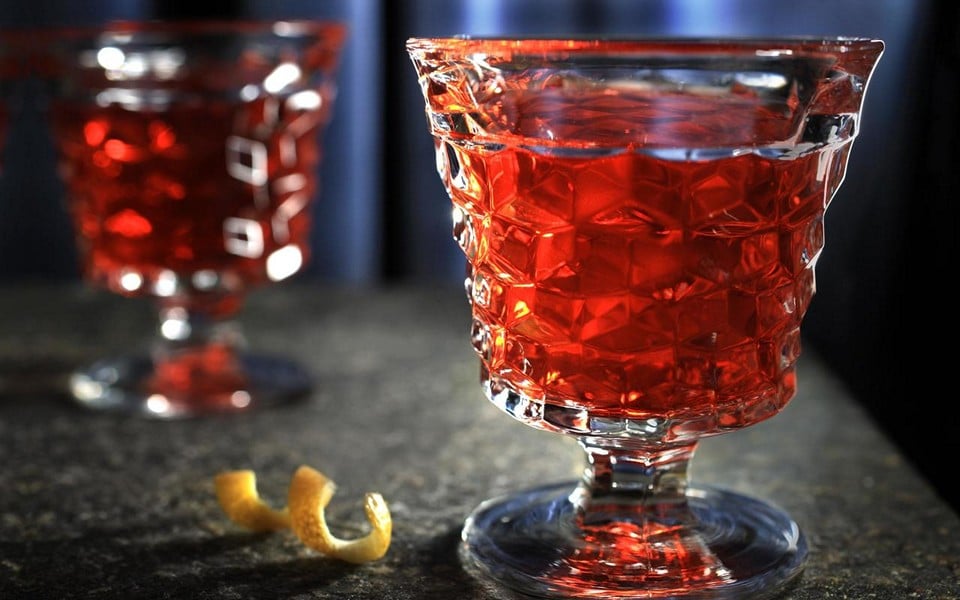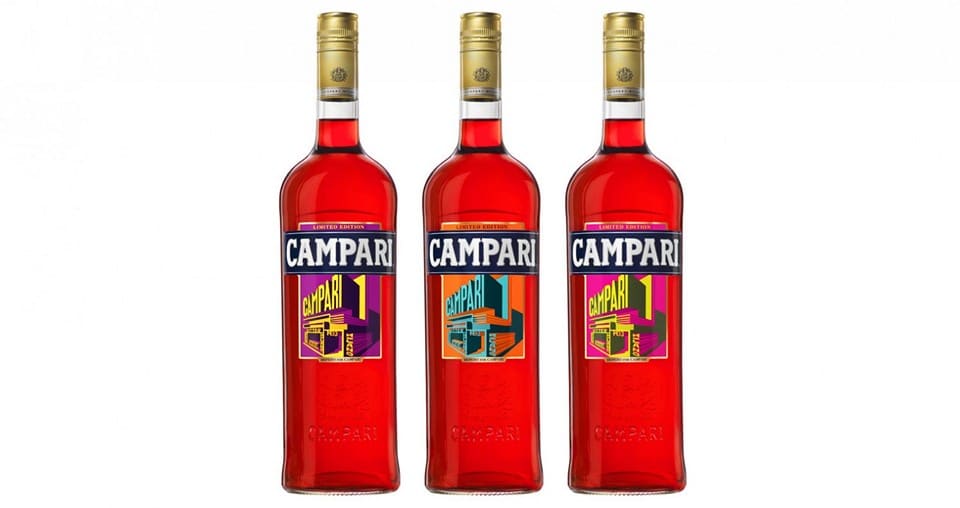Opinion has it that beloved children are named after their parents. We cannot say for certain how true this fact is for all families, but at Campari, it holds completely true. The namesake liqueur is their most popular and sought-after creation. Campari, dressed in a deep red color and sealed with a golden label, excels both in cocktail compositions and on its own. It is exported to nearly 190 countries worldwide. To get closer to the star without getting burned in the rays of its fame, our article will guide you.
Page Contents
Historical Background of Campari
The history of Campari dates back to the 1840s when Gaspare Campari began experimenting with the production and sale of alcoholic beverages. He spent two decades creating bitter aperitifs before arriving at the famous recipe.
In the late 1860s, Gaspare and his family moved to Milan, where he opened the “Campari” café. The establishment became the birthplace of the Milan-Torino cocktail, later renamed the Americano.
In the 1880s, the creator of the liqueur collaborated with local artists to immortalize his creation in art, thereby boosting its sales through advertising posters.
In 1904, the historic Campari production site in Sesto San Giovanni was established, which still exists today.
In the 1920s, management of the company passed to Gaspare’s sons. They discontinued the production of all beverages except Campari liqueur. After a hiatus due to World War II, mass production of the bitter aperitif resumed in the late 1940s. It was during this time that a new advertising campaign was launched under the guidance of artist Carlo Fisanotti.
Throughout the years since the invention of the liqueur, the recipe has changed only once.
From the very beginning, carmine was used by producers to obtain its distinctive red color. Carmine is a dye derived from dried and ground cochineal insects. Due to pressure from vegetarians, the company switched to artificial dyes in 2006.
What Is This Beverage?
Campari is a bitter aperitif with a rich aroma and intense ruby color. It is a blend of herbal and spice infusions, alcohol, water, and sugar syrup.
The exact recipe for Campari, like many unique beverages, is kept a closely guarded secret. Even the employees at the distillery are unaware of the specific ingredients used. All the containers holding the components are simply numbered.
The taste of the liqueur can be divided into three stages:
- It starts with sweetness, but not excessive, which fades relatively quickly.
- Next, the bitterness unfolds with dominant notes of bitter orange and gentian.
- The aftertaste is characterized by herbal notes.
Production Technology
During the production process, the dried ingredients are soaked in water for about two days. Then the infusion is mixed with alcohol and a large amount of water and matures in large tanks for just over two weeks. At the end of this period, the color of the beverage is brown, and the taste is very bitter.
The liquid is then drained, and the herbal residue is strongly pressed, similar to squeezing a tea bag, to extract the maximum amount of infusion. Additionally, the remaining residue is boiled to extract as much alcohol as possible.
Finally, the herbal infusion is blended with sugar syrup and red artificial coloring.
Before bottling, the alcohol content in different batches of Campari is adjusted according to the final destination. For example, beverages with an alcohol content of 28.5% are sent to Eastern European countries, while those with 24% alcohol content are destined for the American markets. Furthermore, the bottles sold in the USA are labeled “Aperitivo” instead of the usual “Bitter.” This is because the former is slightly more appealing to Americans than, let’s say, the label “Poison.”
Nowadays, a significant amount of liqueur is sold abroad, but Italians remain the main consumers of Campari. Although it is often not consumed in its bitter form, but rather as Camparisoda. This is a ready-made cocktail with an alcohol content of 10%, invented by Davide Campari. It consists of 1 part Bitter and 2 parts soda water. It is sold in bottles with a characteristic, cone-like shape.
How Is It Usually Consumed and What Can It Be Paired with?
If you are new to consuming Campari Bitter, it is not recommended to drink it neat. It is optimal to mix the liqueur with orange or grapefruit juice. The drink is usually served on its own, typically before a meal, in combination with citrus flavors or something sweet to balance out the bitter taste.
Remember that a single Campari is always accompanied by ice cubes.
The tradition of drinking Bitter before a meal is associated with the fact that the herbal extracts in its composition aid in good digestion.
Campari Cocktails
People often wonder how to make Campari liqueur at home. There is only one answer to this question: you can’t! Because the manufacturer keeps its recipe in the strictest confidence. And all attempts to replicate the composition randomly are unlikely to succeed.
But the good news is that you can easily create a cocktail based on Bitter with an incredibly amazing taste in your own kitchen. We present to you the 10 most famous and astonishing drinks that everyone should know.
Americano
Americano is one of the first cocktails based on Campari. Originally, it was known as Milan-Torino. This drink has a subtle aroma but a strong refreshing effect, making it perfect for hot days.
Components:
- 1.5 fl oz (45 ml) Campari
- 1.5 fl oz (45 ml) sweet vermouth
- 2-3 fl oz (60-90 ml) soda water
In a highball glass filled with ice, pour Campari and vermouth. Top it off with soda water and garnish the glass with an orange twist.
Boulevardier
Boulevardier is a slightly forgotten autumn cousin of the Negroni. In this cocktail, gin is replaced with whiskey. While the connection between Campari and sweet vermouth remains, whiskey fundamentally changes the “plot.” The drink has a rich and vibrant flavor.
Components:
- 1 fl oz (30 ml) whiskey
- 1 fl oz (30 ml) Campari
- 1 fl oz (30 ml) sweet vermouth
In a shaker, mix all the ingredients with crushed ice, shake for 20 seconds, and strain into a chilled cocktail glass. Garnish with a cherry or an orange twist.
Bitter Sangria
Bitter Sangria is a variation of the classic Sangria, which is typically made with red wine. However, this version adds an unexpected bitterness with the inclusion of Campari at the center of its flavor profile.
Components:
- 13.5 fl oz (400 ml) red wine
- 3.4 fl oz (100 ml) cranberry syrup
- 5.1 fl oz (150 ml) bourbon
- 5.1 fl oz (150 ml) Campari
- 1 orange
- Chilled sparkling mineral water
- Fresh cranberries
In a 1-liter jar, pour red wine, cranberry syrup, bourbon, and Campari. Stir well to combine. Slice the orange into round slices, placing half of them into the mixture. Refrigerate until fully chilled.
To serve, fill a glass halfway with the Sangria mixture and dilute it with 2-3 fl oz (60-90 ml) of sparkling mineral water. Garnish the drink with an orange slice and cranberry halves.
Jasmine
Jasmine is a captivating cocktail. Its pleasant pink color creates the impression of a drink for sophisticated ladies. However, the twist comes from the addition of bitter Campari rather than harmless cranberry syrup. The taste of Jasmine vaguely resembles grapefruit juice. It is intense and invigorating.
Components:
- 0.5 fl oz (15 ml) gin
- 0.7 fl oz (20 ml) freshly squeezed lemon juice
- 0.3 fl oz (10 ml) Campari
- 0.3 fl oz (10 ml) Cointreau
Mix all the components in a shaker with ice for 10 seconds. Strain the mixture into a chilled cocktail glass and garnish with a lemon twist.
Campari Spritz
Campari Spritz is a sibling of the Aperol Spritz. However, the latter is milder, while the cocktail based on Campari is bold and assertive. It is typically served with green olives, which serve as a surprisingly tasty companion to the slightly bitter and tangy cocktail. It also pairs well with cheeses and cured meats.
Components:
- 2 fl oz (60 ml) Prosecco sparkling wine
- 2 fl oz (60 ml) Campari
- 1 fl oz (30 ml) soda water
In a glass with ice, pour the Prosecco, Campari, and soda water in that order. Gently stir to combine and garnish with olives.
Negroni
Negroni is a classic cocktail that owes its longevity to its reliable taste. It consists of just three ingredients in equal proportions. It has been proven that even a novice bartender cannot ruin a Negroni.
Components:
- 1 fl oz (30 ml) gin
- 1 fl oz (30 ml) Campari
- 1 fl oz (30 ml) sweet vermouth
In the traditional method of making the cocktail, pour all the components into a glass filled with ice, stir well, and garnish with an orange zest (if desired).
Negroni Sbagliato
Negroni Sbagliato (meaning “wrong” in Italian) is a cocktail that even if you mess up, you can still create something delicious.
Components:
- 1.5 fl oz (45 ml) sweet vermouth
- 1.5 fl oz (45 ml) Campari
- 1.5 fl oz (45 ml) Prosecco or other sparkling wine
In a tumbler filled with ice, pour the sweet vermouth and Campari, and stir well. Top it off with the sparkling wine and garnish with an orange slice.
Jungle Bird
Jungle Bird is a cocktail where the quality of pineapple juice plays a significant role in its flavor. Ideally, fresh squeezed juice is used, or whole pieces of fruit are muddled and added to the cocktail along with the pulp.
Components:
- 0.5 fl oz (15 ml) fresh lime juice
- 0.5 fl oz (15 ml) simple syrup
- 0.75 fl oz (20 ml) Campari
- 1.5 fl oz (45 ml) fresh pineapple juice
- 1.5 fl oz (45 ml) Cruzan blackstrap rum
Combine all the components in a shaker with ice and shake vigorously for 30 seconds. Serve in a Moscow Mule mug.
Upgraded Paloma
The Upgraded Paloma is a modern twist on the famous Paloma cocktail. Citrus notes provide a tangy flavor that is complemented by the herbaceousness of tequila, the bitterness of Campari, and a subtle salty hint. What sets this drink apart is its ability to be prepared in larger quantities and stored in the refrigerator for up to a week. It can be enjoyed not only as a cocktail but also used to enhance the taste of freshly cut fruits or ice cream.
Ingredients for the salted grapefruit component:
- 3.4 fl oz (100 ml) freshly squeezed red grapefruit juice;
- Zest of 1 grapefruit;
- 7 oz (200 g) sugar;
- 1.7 fl oz (50 ml) lime juice;
- 1.7 fl oz (50 ml) water;
- 1 ½ teaspoons of salt.
Cocktail ingredients:
- 2 fl oz (60 ml) Blanco tequila;
- 1 fl oz (30 ml) prepared citrus liquid;
- 0.7 fl oz (20 ml) freshly squeezed lime juice;
- 0.3 fl oz (10 ml) Campari;
- Mineral water.
To prepare the citrus component, combine the grapefruit zest with sugar and refrigerate for 24 hours. After 2 days, add grapefruit juice, lime juice, water, and salt. Stir until the sugar and salt are fully dissolved. Remove the grapefruit zest and chill.
For the cocktail, shake ice with all the necessary components, except for the mineral water, in a shaker. Shake well for about 15 seconds. Pour into a Highball glass. Top with mineral water and garnish with a grapefruit slice.
Old Pal
The Old Pal is a cocktail for winter evenings. It is based on bourbon, which provides a robust aroma, and Campari, which adds bitterness. The taste of the drink is rich and complex.
Ingredients:
- 1.5 fl oz (45 ml) bourbon;
- 0.7 fl oz (20 ml) dry vermouth;
- 0.7 fl oz (20 ml) Campari.
Pour all the ingredients into a shaker filled two-thirds with ice. Stir for about 20 seconds. Strain the cocktail into a chilled glass and garnish with a lemon twist.
Price of Campari in Italy
The price of Campari liqueur in Italy varies depending on the seller. It ranges from 10 to 20 Euros for a 750 ml bottle.
The popular Italian aperitif Camparisoda is mostly sold in packs of several 150 ml bottles. The price for a pack of 10 bottles is no more than 10 Euros.
Smoothly, gently, and without any bitterness, we have presented you with all the information about Campari liqueur. Drink responsibly, love soberly, travel bravely, and remember: “Opposites attract only in Campari!”
Intresting Facts about Campari
- Campari, the iconic bitter ruby aperitif, was created in 1860 by Gaspare Campari in Novara, Italy. Its secret recipe, known only to a few individuals, includes a blend of herbs, spices, and fruits, resulting in its distinctive and complex flavor profile.
- The vibrant red color of Campari comes from the addition of cochineal, a natural dye derived from crushed insects. This ingredient gives Campari its characteristic hue and adds to its allure as a visually striking beverage.
- Campari gained international recognition and popularity in the early 20th century when it became a favorite among artists, writers, and bohemian circles. Its bitter yet refreshing taste made it an ideal aperitif to stimulate the palate before a meal.
- Negroni, one of the most famous cocktails in the world, features Campari as a key ingredient. The classic Negroni recipe includes equal parts Campari, gin, and sweet vermouth, garnished with an orange peel. This timeless cocktail has been enjoyed since its creation in the early 1900s.
- Campari has a distinct bitterness that comes from the infusion of herbs and botanicals during its production. This bitterness is balanced by underlying citrus and fruity notes, creating a complex flavor that can be an acquired taste for some but is beloved by many.
- The alcohol content of Campari is 24% by volume, making it a potent aperitif. Its bold and intense flavor profile, combined with its relatively high alcohol content, makes it a versatile ingredient for creating unique and flavorful cocktails.
- Campari has become synonymous with the Italian aperitivo culture, where people gather before dinner to enjoy a leisurely drink and appetizers. It is often served over ice with a splash of soda water and garnished with an orange slice or peel, allowing its flavors to mellow and develop as it is slowly savored.
 Italy for me From Italy with love
Italy for me From Italy with love

